Apple's 2010 MacBook Air (11 & 13 inch) Thoroughly Reviewed
by Anand Lal Shimpi on October 26, 2010 10:08 PM EST- Posted in
- Mac
- Apple
- MacBook Air
- Laptops
The SSD: Not Half Bad
Apple advertises the new MacBook Air as being instant on as a result of the internal SSD. That’s mostly untrue. From a completely powered off state the MacBook Air still takes time to boot. That time is significantly reduced compared to the old MacBook Air and any other Mac with a conventional hard drive. It’s even a shorter boot than my MacBook Pro with a SandForce SF-1200 based SSD in it:
| System Performance Comparison | ||||||
| Boot | Shut Down | Sleep | Awake | |||
| 11-inch MacBook Air | 15.5 seconds | 2.2 seconds | 1.0 second | 1.63 seconds | ||
| 13-inch MacBook Air | 14.4 seconds | 1.9 seconds | 1.0 second | 1.56 seconds | ||
| 13-inch MacBook Air (Late 2008) | 34.4 seconds | 2.9 seconds | 1.6 seconds | 4.19 seconds | ||
| 15-inch MacBook Pro (SF-1200 SSD) | 19.1 seconds | 1.8 seconds | 1.5 seconds | 2.3 seconds | ||
| 15-inch MacBook Pro (Mid 2009, HDD) | 34.2 seconds | 2.8 seconds | 1.8 seconds | 2.1 seconds | ||
You'll notice that even the SF-1200 SSD in my 15-inch MacBook Pro takes longer to boot than these new Airs. Apple does customize the firmware on its SSDs. I’d be willing to bet the SSD in the MacBook Air has tight integration with OS X to guarantee quicker than normal boot times.
Clearly the new Air isn't instant on from a boot standpoint, but it's pretty much there from a recover-from-sleep standpoint. The new Airs both go to sleep and wake up from sleep quicker than any of the other Macs, including my upgraded 15-inch Core i7 MacBook Pro. Again, nothing can trump Apple's tight integration between hardware and software.
Apple likes to work with two different controller manufacturers for SSDs: Samsung and Toshiba. iFixit already confirmed Toshiba is in the new MacBook Air with its teardown:
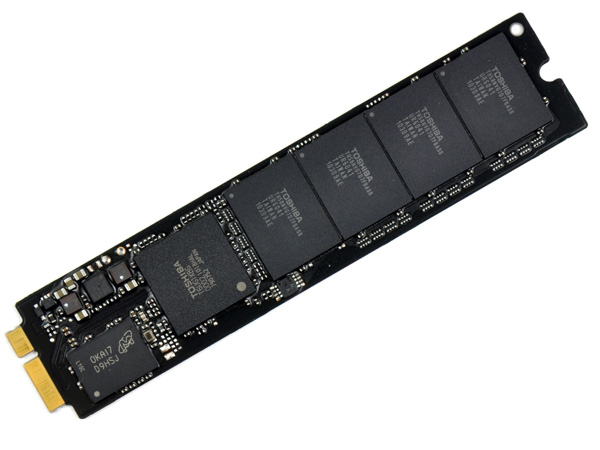
The 11-inch MacBook Air SSD, courtesy of iFixit
The SSD isn’t in an industry standard form factor, although the connector appears to be either micro or mini SATA. Presumably 3rd party SSD manufacturers (ahem, SandForce partners I’m looking at you) could produce drop in replacements for the MacBook Air SSD.
There’s nothing particularly innovative about the form factor of the SSD, other than Apple did away with the unnecessary space a 2.5” SSD would require. Just as SSDs will break the traditional SATA interface barriers, we’ll see the same happen to form factors as well.
The part number on the Toshiba controller may look familiar to some of you. It’s the same controller that’s in Kingston’s SSDNow V+ Series and the SSDNow V Series Boot Drive. I reviewed the latter not too long ago and found that it was a good drive for the money, and here’s the kicker: the SSDNow V Series Boot Drive was amazingly resilient when written to without TRIM support. Its performance hardly dropped as a result of normal desktop use. This is very important because although OS X 10.6.4 has a field for reporting TRIM support on an SSD, the instruction isn’t actually supported by the OS. Even the new MacBook Airs don’t ship with a version of OS X with TRIM support.
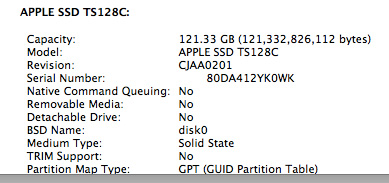
The SSD only has four NAND devices on it. Typically that would mean some very low transfer speeds, particularly on writes. But each one of those four devices has at least 16GB of NAND, spread across multiple planes and die. With the right firmware, you should be able to extract a good deal of parallelism from this architecture. Apple and Toshiba apparently do just that.

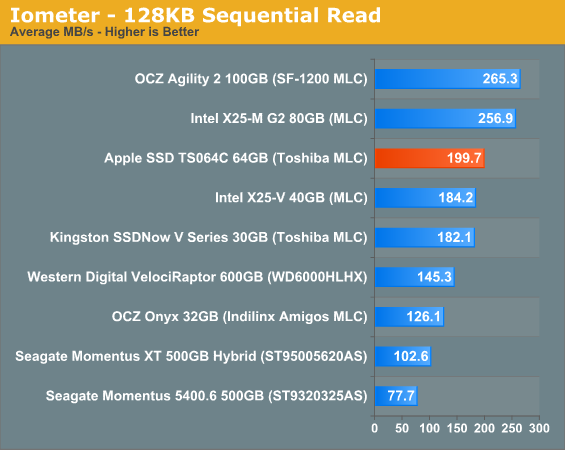
While most value SSDs top out at under 100MB/s, we get nearly 200MB/s sequential reads and writes out of the SSD in the new MacBook Air. And fortunately, Apple hasn’t only focused on sequential performance. The random read/write performance of the new MacBook Air SSD isn’t terrible:
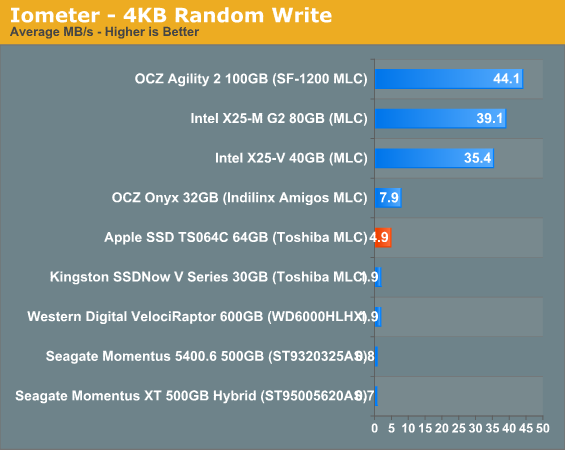
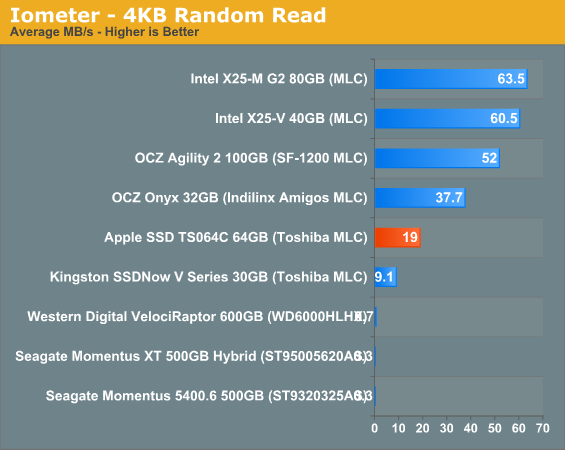
Random write performance is of course the weak point, but you’ll notice that it’s actually higher than the Kingston drive that uses the same controller. While Apple would’ve been better off striking a deal with Intel or SandForce for the controller in the MacBook Air, the Toshiba controller isn’t horrible.
As I mentioned earlier, resilience is very important as OS X still doesn’t support TRIM. I filled the drive with garbage and then tortured it for 20 minutes with random writes. The resulting performance drop was noticeable, but not unbearable:
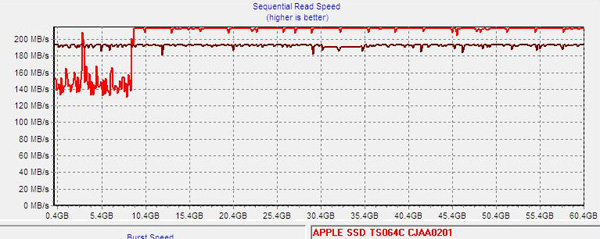
A single pass of sequential writes restores performance to normal:
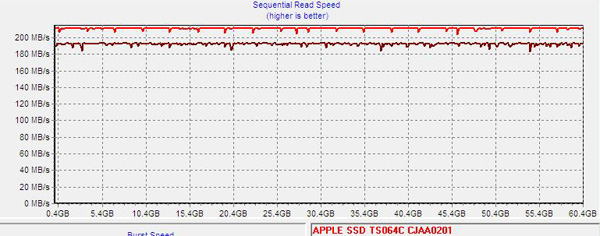
This tells us two things. First, through normal use the drive should be able to recover its performance over time (assuming you give it enough spare area). And second, if there’s any idle garbage collection in Apple’s custom firmware for the Toshiba controller it should be able to keep the drive running at peak performance even without TRIM supported in the OS. I don’t have a good way of measuring whether or not there’s GC enabled on the drive in OS X, but I suspect Apple is (at least it appears to be doing so on the Mac Pro’s SSDs).
Overall I’m pleased with Apple’s SSD selection. It could’ve been a lot better but it could’ve been a lot worse. The MacBook Airs in their default configuration have better IO performance than any other standard config Mac sold on the market today, including the Mac Pro.










185 Comments
View All Comments
nvidia2008 - Wednesday, October 27, 2010 - link
Great article, just one niggle, Instant On does not refer to Boot, nor Wake From Sleep.From the Apple website:
"And when you put MacBook Air to sleep for more than an hour, it enters what’s called standby mode. So you can come back to MacBook Air a day, a week - even up to an entire month later - and it wakes in an instant."
http://www.apple.com/macbookair/design.html
Instant On refers to a Standby Mode (basically hibernate) that is not Boot nor Wake From Sleep.
AMDJunkie - Wednesday, October 27, 2010 - link
This is a good point; Macs with hard drives have "deep sleep" standby, which is the typical, "Hey, your battery is about to die so we're taking the system state from RAM to the hard drive" hibernation. This is an SSD, though, so I presume it writes it to the SSD after an hour, instead of after your battery dips under 5%, to help you save battery.nvidia2008 - Wednesday, October 27, 2010 - link
Yeah, I think Deep Sleep is the most closely related thing to Instant On, not Boot or Wake From Sleep. Cheershechacker1 - Wednesday, October 27, 2010 - link
OS-X, when put to sleep by closing the lid, will write out the necessary parts of memory to the hard drive.Then if your battery dies, the hibernate state resumes when you plug it back in.
If you have a ton of applications open and are using a lot of ram before closing the lid, it does take noticeably longer to actually begin sleep and turn off the HD, as indicated by the light on the macbook.
tipoo - Wednesday, October 27, 2010 - link
Yeah, Instant On is really just fast-wake-from-hibernate.Tuntavern - Wednesday, October 27, 2010 - link
Now there ARE two.ginny - Wednesday, October 27, 2010 - link
HiYou had said that your macbook air was using about 1.4 gb of memory when diting a handful of imgs in Photoshop. Do you think then that it isnt the best machine to get if I anticipate in using Adobe CS frequently? Do you think i should opt for a MBP instead? Or will upgrading the CPU and Memory suffice?
Thanks!
zhill - Wednesday, October 27, 2010 - link
Good review. I was waiting for you guys to review the new airs, good data. FYI, your images comparing the 13" MBA's size appear to be labeled incorrectly. I think the image (http://images.anandtech.com/reviews/mac/macbookair... is comparing the MBA 13" to the MBP 15" rather than the MBP 13".I'm also surprised that the screens had such a limited color gamut, I expected something in the 70% range rather than 40% but I suppose they trade that for energy efficiency(?).
I would be very curious to see your benchmarks include a new air with the 2.13GHz C2D and 4GB RAM to compare that to the the 1.86Ghz. I seem to recall that the last generation 2.13Ghz Air had even more thermal throttling issues than the lower spec chip so I wonder if it has been addressed in that configuration as well.
Any ideas on how they achieved such a fast wake time compared with the MBP 15" w/SSD? Typically, a sleep/wake operation is not very dependent upon the disk as the memory is kept powered so the system state should easily be restored without much disk access. Interesting stuff.
dsee15 - Wednesday, October 27, 2010 - link
Great Review, thank you!How much faster do you think the 13 MBA with 2.1Ghz proc, 4GB Mem, 256GB SSD would be over the stock model you tested? Do you think the faster proc will generate too much heat and initiate the governor?
How would this 'tricked out' system run VMware/windows/office?
Lastly, it appears the tricked out version could out perform both the 13 MB aluminum with hard drive and 13 MBP with hard dive, except for the most cpu intensive apps, agree...??? Could it replace a 15 MBP with hard drive?
doubledown21 - Wednesday, October 27, 2010 - link
Will there be any updates to the benchmarks if/when the 2.13GHz MBA is tested?